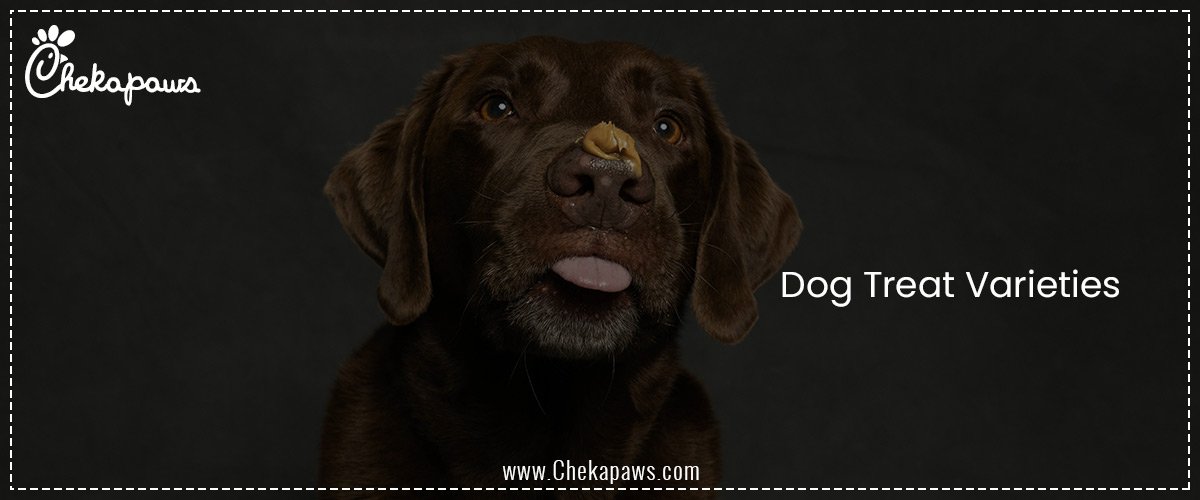As a dog parent, I am aware that while dog treats might appear like insignificant incentives, they have a significant impact on a dog’s everyday existence. Treats are much more than simply delicious morsels; they may help with training, dental health, and even emotional well-being, as well as fostering a closer link between pet and owner.
However, selecting the appropriate treat necessitates knowing your dog’s particular requirements, preferences, and way of life. Not all treats are made equal; depending on a dog’s age, breed, health, and activity level, what works well for one may not work for another.
This in-depth guide will cover every type of dog treat that is currently on the market, including homemade alternatives, freeze-dried raw options, dental sticks, and natural jerky bites and soft chews. Additionally, you will learn how to choose treats that will make your dog healthier rather than heavier, read labels, and steer clear of dangerous substances.
Table of Contents

The Role of Dog Treats in Training, Bonding, and Health
It’s important to understand why treats are so important in a dog’s life before going into the variations.
For training
Among the best methods for training dogs is positive reinforcement. Treats encourage dogs to repeat commands like “sit,” “stay,” or “come” by serving as a reward for excellent behavior. Training rewards ought to be:
- Little and simple to chew
- Minimal calorie intake
- Fast to eat (to avoid interfering with training flow)
- Very tasty to keep you motivated
For Bonding
Treating your dog when they’re playing, after they’ve been groomed, or just because they’re cute improves your bond. When they are rewarded, dogs connect your voice, smell, and behavior to joy.
For Well-Being and Development
For better health, a lot of modern dog treats are made with extra nutrients like glucosamine, probiotics, or omega fatty acids. Others, such as chew treats that keep dogs occupied and relaxed, offer cerebral stimulation.
The Main Categories of Dog Treats
Dog treats can be divided into a number of categories according to their ingredients, texture, and intended use. Let’s discuss each in greater depth.
Crunchy Biscuits and Cookies
These sweets, which resemble tiny cookies or biscuits, are probably the most traditional type.
Features
- Usually cooked, and they keep well for a long time.
- Excellent for tooth scraping and minor eating
- Tastes include cheese, bacon, peanut butter.
Ideal for
- Dogs that are adults and like a good crunch
- Rewarding after playtime or walks
- Whole grains, peanut butter, pumpkin, oats, and natural flavoring are common ingredients.
Caution
Avoid biscuits that include a lot of fillers, corn syrup, or artificial coloring
Soft and Chewy Treats
For training and older dogs with sensitive teeth, these are ideal because they are soft and moist.
Features
- Simple breaking into tiny fragments
- Strong fragrance that captures a dog’s interest during training
Ideal for
- Seniors, puppies, and finicky eaters
- Fast rewards
Tip
Keep soft treats in an airtight container to prevent them from spoiling too quickly.
Freeze-Dried and Dehydrated Treats
Because they preserve the essential nutrients of the raw materials, these are among of the healthiest choices.
Features
- Made without cooking by eliminating moisture.
- Recipes with just one or a few ingredients
Benefits
- High density of nutrients
- Absence of artificial preservatives
Perfect For: Raw-diet dogs or dogs with food allergies.
Dental Chews
The purpose of these treats is to promote dental health.
Functions
- Reduce the growth of tartar and plaque
- Cleanse your breath
- Promote good chewing practices
- Among the well-known brands are Pedigree Dentastix, Whimzees, and Greenies.
Ingredients – Usually composed of natural abrasives, chlorophyll, and digestible starches.
Veterinary Tip – For dental chews that have been shown to be successful, choose those bearing the VOHC (Veterinary Oral Health Council) seal.
Long-Lasting Chews
These provide fun and satisfy your dog’s need to chew.
Examples
- Use only digestible types of rawhide.
- Bully sticks
- Chews of yak cheese
Benefits
- Keeps dogs busy
- Helps in stopping harmful conduct
- Caution: To avoid choking or intestinal blockages, always keep an eye on them.
Functional Treats
These are packed with nutrients to meet particular health requirements.
Among the types are
- Support for the hip and joints: Using glucosamine and chondroitin
- Skin and coat maintenance: biotin and omega-3 enriched
- Probiotics help with digestive health
- Treats for relaxation: Using chamomile, L-theanine, or CBD (if permitted)
When to Use – Perfect for older dogs or those that want extra nourishment in between meals.
Puppy Treats
Puppies’ digestive systems are still developing, their mouths are smaller, and their teeth are softer.
Features
- Little and soft
- Easy on the stomach and teeth
- Improved with calcium and DHA
The best uses include teething alleviation, obedience training, and crate training.
Grain-Free and Limited Ingredient Treats
- Suitable for dogs who have food sensitivities or allergies.
- Common ingredients include coconut flour, chickpeas, lentils, and sweet potatoes.
- Sources of protein include venison.
- Why Pick Them: They lower the chance of ear infections, skin irritation, and digestive disorders.
Choosing the Right Treat for Your Dog
Consider Age
- Puppies: Require smaller, softer, higher-protein snacks.
- Adults: Able to savor a variety of chewy and crunchy delicacies.
- Seniors: Joint supplements should include soft, low-fat choices.
Consider Size and Breed
Large breeds require little bites, whilst large animals like robust chews.
Nutritional Requirements
If your canine companion possesses:
- Obesity: Select goodies that are low in calories or made from vegetables.
- Allergies: Choose hypoallergenic or limited-ingredient treats.
- Choose freeze-dried single-protein treats if you have a sensitive stomach.
Preferences for Texture – Dogs have unique taste preferences, just like people. Find out if your dog likes meaty, chewy, or crunchy textures by experimenting.
Reading Labels — What to Look For (and Avoid)
You can differentiate between healthy and unhealthy sweets by reading ingredient labels.
Look for
The first ingredient is real meat; there aren’t many fillers like rice, oats, or chickpeas; there are natural preservatives like vitamin E or rosemary extract; and there are extra nutrients like glucosamine and omega-3s.
Avoid – Artificial flavours and colours Too much sugar or salt Propylene glycol, corn syrup, or BHA/BHT By-products whose origins are uncertain
Calories Also Matter – No more than 10% of your dog’s daily calories should come from treats. Pay attention to the number of calories in each reward, particularly for little breeds.
Specialty Treat Varieties
Natural Dog Treats
- Treats that are certified organic stay away from artificial additives, hormones, and pesticides.
- Examples include free-range chicken jerky and organic apple and carrot biscuits.
- Why Choose Them: For sensitive canines and environmentally aware owners.
Vegan and Vegetarian Treats
- For dogs who are allergic to animal proteins, vegan alternatives are best.
- Among the ingredients are spinach, sweet potatoes, carrots, lentils, and peanut butter.
- Note: Since dogs are omnivores, vegan snacks are OK on occasion but shouldn’t be used in place of well-balanced meals.
Gourmet and Bakery-Style Treats
- These days, dog bakeries sell human-quality, handcrafted cookies, cupcakes, and even birthday cakes!
- Things like milestones in training, holidays, and birthdays.
- Use these as infrequent treats only because they are frequently higher in sugar.
Treats for Working Dogs and Athletes
High-protein, energy-dense treats are great for dogs involved in agility, hunting, or police work.
Seasonal Treats
Celebrations are made more enjoyable with festive snacks like peppermint bones for winter or pumpkin biscuits for autumn. Just be careful not to include things like chocolate or xylitol.
Treat Varieties by Form
Strips and Sticks – Simple to take apart and perfect for informal rewards.
Nuggets and Cubes – Great for portion control and training sessions.
Treats That Can Be Spread – Kongs and other puzzle toys can be made with peanut butter-style dog spreads.
Pastes and Liquids – Helpful for motivating finicky eaters or giving medicine.
Freeze Pops – For cooling respite, freeze dog-safe yoghurt or broth to make summertime treats.
How to Use Treats Wisely
For Support
To improve associations, just give rewards right after desirable behavior.
In Order to Improve – To keep your dog’s mind active, conceal treats under snuffle mats or puzzle toys.
To Provide Emotional Support – Dogs can be soothed by treats in stressful situations, such as thunderstorms or doctor’s appointments.
For Maintaining Health – Daily dental treatments are recommended; joint-supporting treats may be included in a supplement regimen.
How to Store Dog Treats Properly
Dry Treats – Store in dry, cool places in sealed jars.
Wet Treats – After opening, store in the refrigerator and eat within a few days.
Homemade Treats – Before serving, defrost parts that have been frozen.
Be Careful of Spoilage – Look for discoloration, mold, or a putrid odor.
DIY Dog Treat Recipes (Vet-Approved)
Peanut Butter Oat Balls
Ingredients:
- 1 cup rolled oats
- ½ cup unsweetened peanut butter
- ¼ cup mashed banana
Mix, roll, and refrigerate.
Pumpkin Crunch Biscuits
Ingredients:
- 1 cup pumpkin puree
- 2½ cups whole wheat flour
- 1 egg
Bake at 350°F for 25 minutes.
Frozen Yogurt Pops – Blend yogurt, banana, and blueberries. Freeze in molds.
Treat Safety and Allergies
Keep an eye out for food allergies
Itching, ear infections, or upset stomach are some of the symptoms. If necessary, switch to hypoallergenic treats.
Dangerous Ingredients
Avoid
- Chocolate
- Grapes and raisins
- Garlic powder or onions
- The hazardous artificial sweetener xylitol
Risks of Choking – Always make sure the size of the treat fits your dog’s mouth. Throw away huge chews in small bits.
The Future of Dog Treats
The pet industry keeps coming up with new ideas with:
- Protein treats made from insects that are hypoallergenic and environmentally friendly
- Calming chews with CBD
- Collagen and probiotic-infused functional treats
- Biodegradable wrappers and environmentally friendly packaging
- These patterns indicate a move towards ecologically friendly and health-conscious pet care.
Conclusion
Every dog should get a treat that fits their lifestyle, personality, and level of health. There is something out there that can make your pet happy and provide them with nourishment, regardless of whether they prefer soft training bits, meaty jerky, or crunchy biscuits.
- Keep in mind that the ideal treat is one that:
- Maintains the health of your dog
- Strengthens your relationship
- Promotes the mental and physical health of your dog
- Knowing the types of dog treats that are currently on the market will help you make thoughtful, affectionate decisions that will guarantee every wag of their tail is joyful and healthful.







